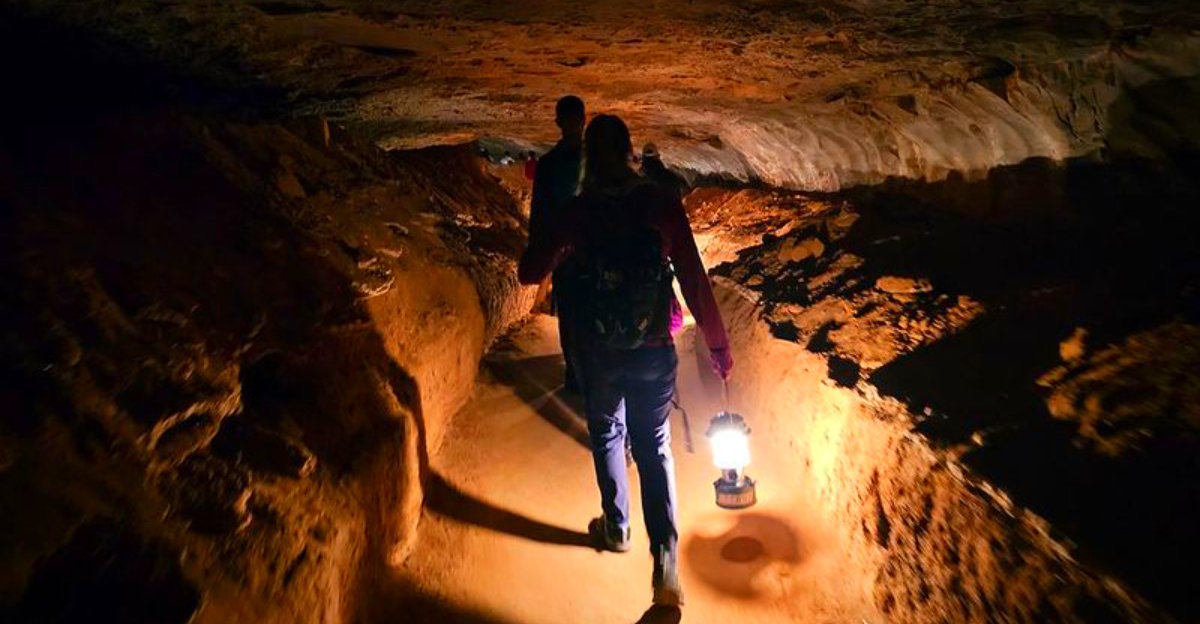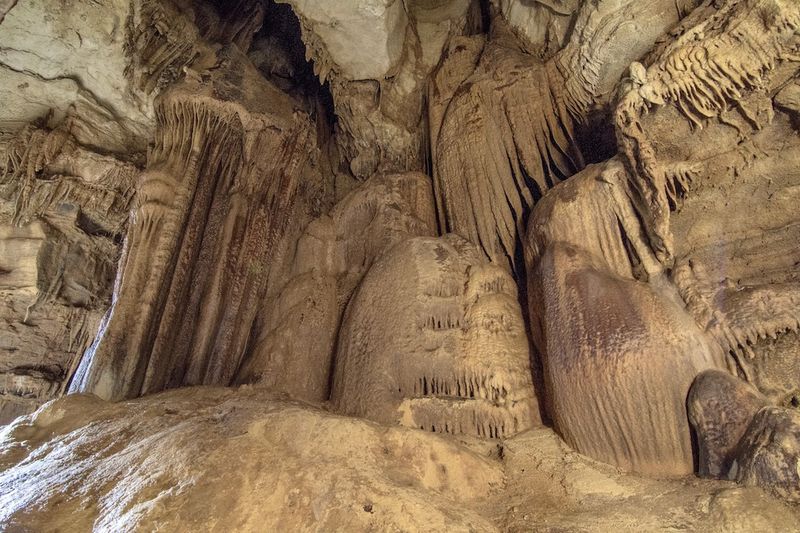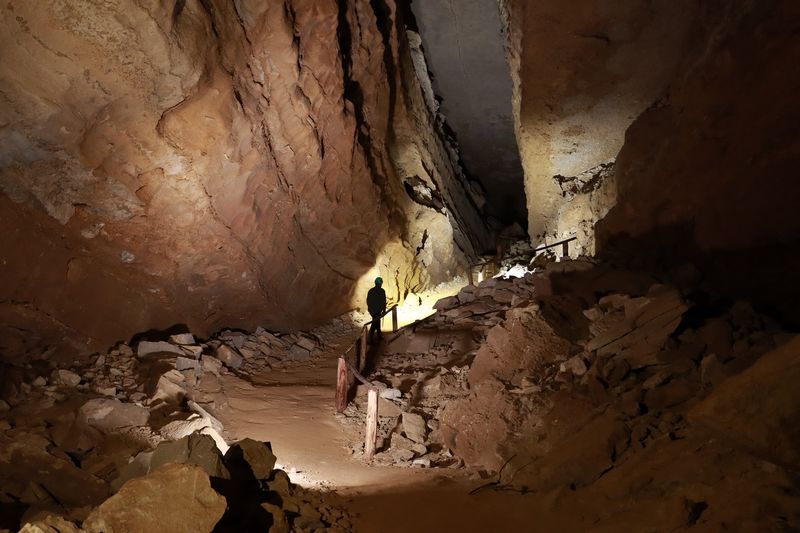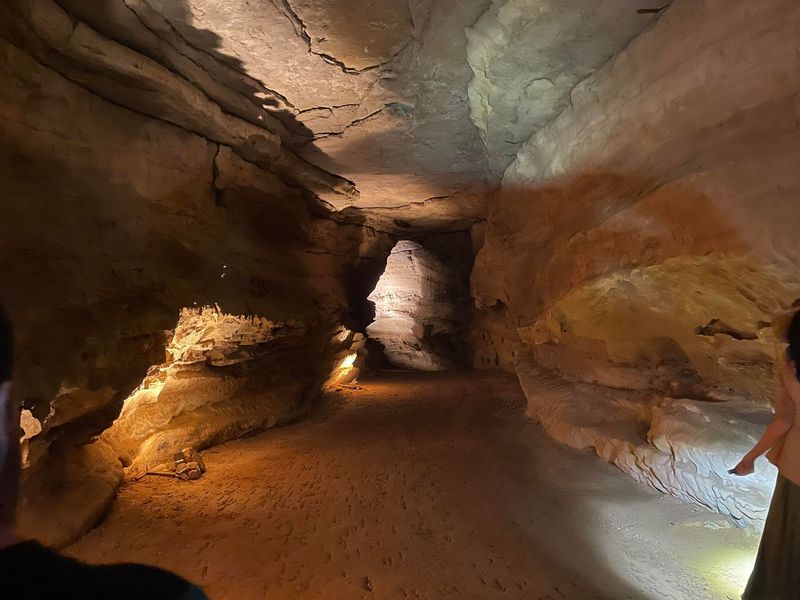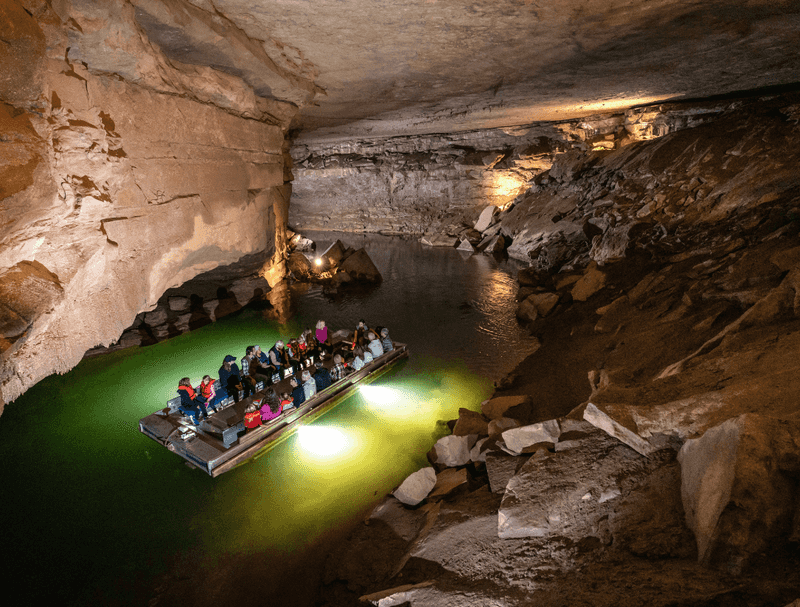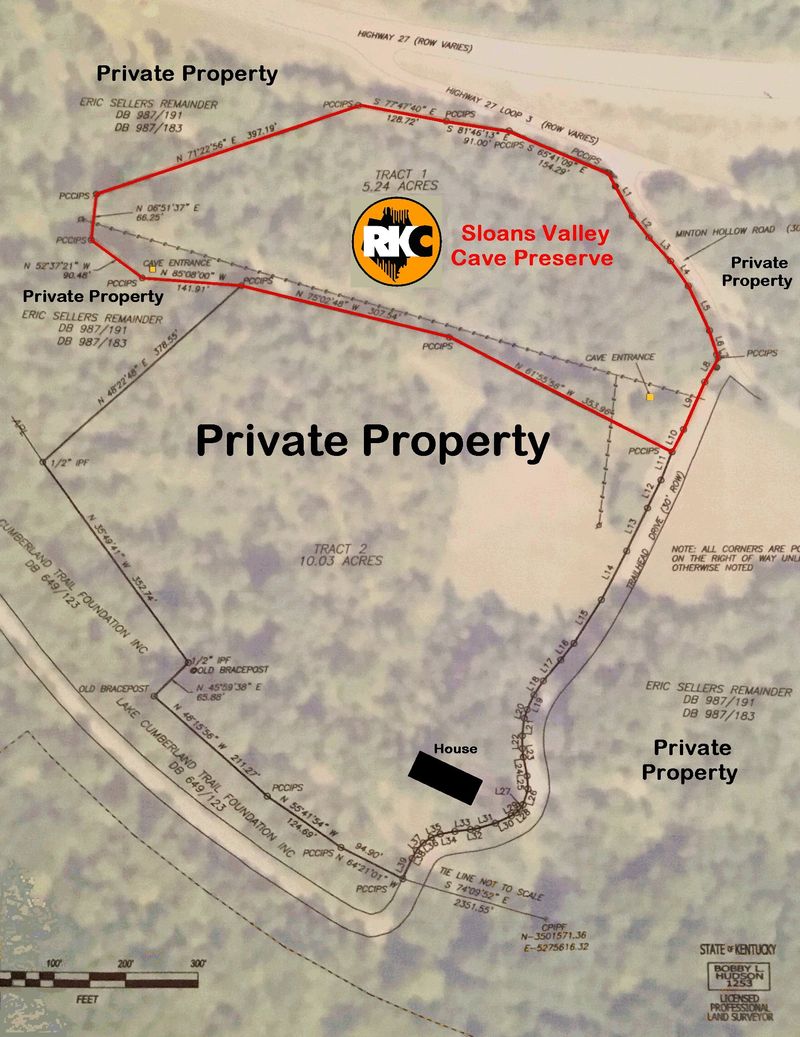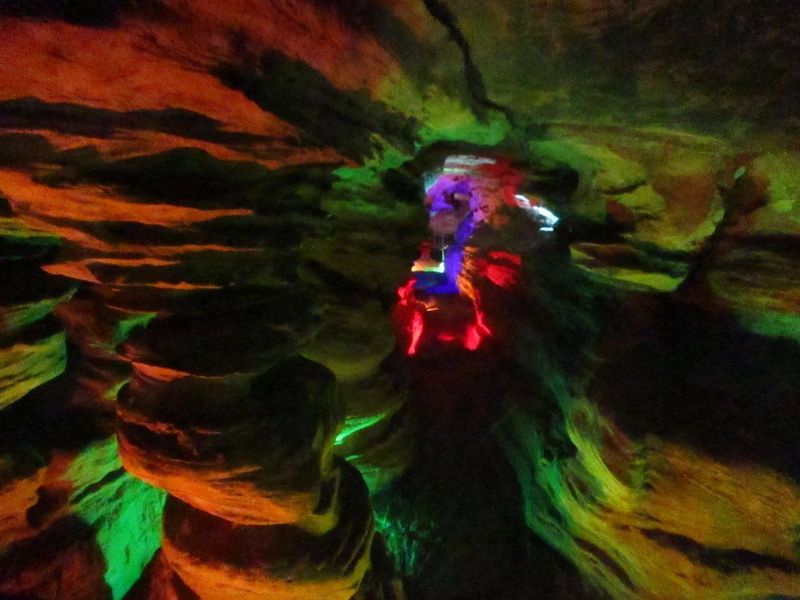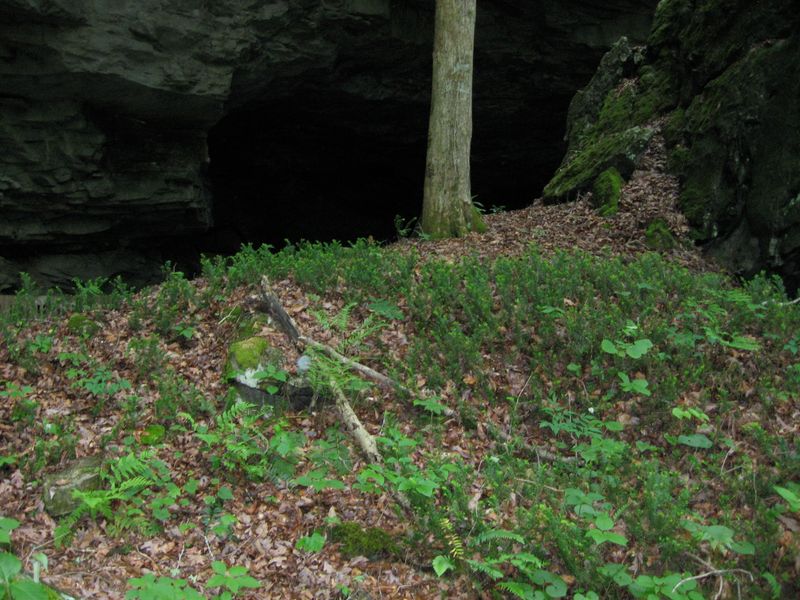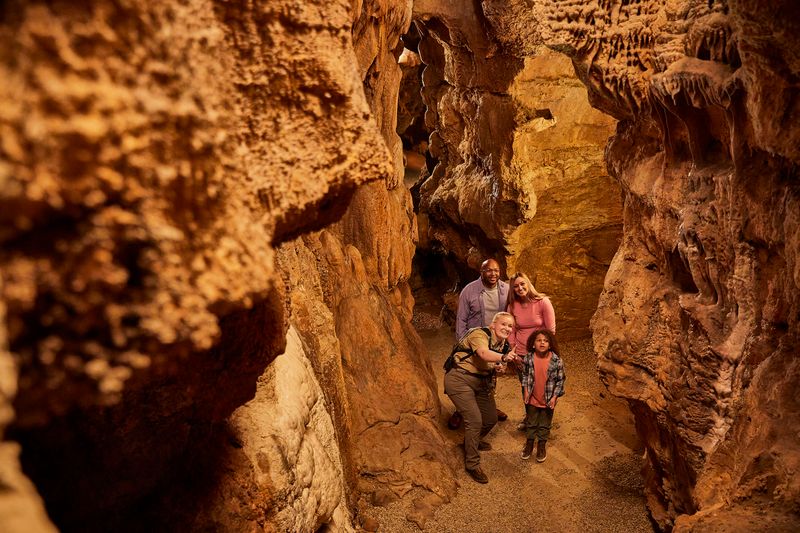Kentucky’s underground hides stories the brochures won’t tell. Beyond the show lights and ticket booths lie shadowed passages, locked gates, and whispered legends locals guard with pride. These are the caves where history lingers, creatures sleep, and unspoiled formations gleam untouched. If you’re craving the thrill of the forbidden and the reverence of true wilderness, step closer – just don’t expect a souvenir shop at the exit.
1. Crystal Onyx Cave (Cave City)
Crystal Onyx Cave rewards patient wanderers with gemlike textures that sparkle as if dusted with frost. Less crowded than nearby attractions, it offers a hush that makes every drip a note in a mineral symphony. Flowstone curtains ripple along the walls, and slender columns rise from mirrored pools. Guides illuminate intricate crystal clusters, revealing patterns like frost on winter windows. The passages feel personal, almost secret, inviting slow footsteps and careful glances. Though accessible, it retains an off-the-map vibe that locals admire. For travelers who crave beauty without bus fumes, this radiant grotto delivers quiet marvels in every chamber.
2. Floyd Collins’ Crystal Cave (Sand Cave Area)
Floyd Collins’ Crystal Cave is hallowed ground in American caving, a place forever entwined with a 1925 entrapment that gripped the nation. The landscape seems to breathe history – cool drafts slide from tight fissures and limestone walls whisper of peril. Access is rare, controlled, and reverent, preserving both geology and memory. Inside, crystal-lined corridors hint at beauty that once promised a tourist empire. Yet tragedy froze time, leaving the site shrouded in caution and lore. Locals respect its quiet, hoping seekers arrive with humility. Here, the thrill of exploration meets the weight of consequence, and echoes drift into silence.
3. Great Saltpeter Cave (Rockcastle County)
Great Saltpeter Cave carries the scent of history as surely as its chilled breezes. During the War of 1812, miners scraped nitre from these walls, feeding gunpowder mills that shaped a young nation’s fortunes. Today, guided access is deliberately limited, honoring fragile passageways and bats that winter here. Carved names and mining relics linger like ghosts among domed rooms and broad avenues. The cave’s scale impresses, but its quiet stewardship impresses more. Step softly, listen for the drip, and let lantern glows pick out textures like parchment. This is a museum of stone – one curated by time and restraint.
4. Gap Cave (Cumberland Gap National Historical Park)
Gap Cave sprawls beneath the storied Cumberland Gap, a labyrinth of multi-level passages where history and geology entwine. Rangers lead small groups through towering domes, slick flowstone stairs, and hidden chambers that breathe cool, mineral air. Daniel Boone once probed these hills; his spirit seems to stride the corridors between dripping curtains. Reservations are essential, ensuring the cave’s quiet persists. Flickers of headlamps catch formations like frozen waterfalls, and distant drips sound like footsteps. It’s not a free-for-all – more a pilgrimage through time and stone. Those who secure a spot step into a hush few will ever know.
5. Lost River Cave (Bowling Green)
Lost River Cave moves to the rhythm of water, a dark artery flowing through cathedral-scale limestone. Boats glide silently into chambers where ceilings arch like ribbed vaults and the river mirrors wavering light. History rides the current – tales of Native footsteps, secret hideouts, and bootleg-era intrigue swirl beneath the drip. Guides manage access carefully, balancing wonder with conservation. The famous blue hole hints at mysterious depths, drawing breath and imagination alike. Even among Kentucky’s big names, this place feels intimate, elemental. It’s a rare chance to float into geology’s heart without overpowering the moment’s fragile magic.
6. Great Onyx Cave (Mammoth Cave NP)
Hidden within Mammoth Cave National Park’s web of stone, Great Onyx Cave glows with creamy bands of calcite that look hand-polished by centuries of drip and time. Once privately owned, its guarded passages kept formations pristine, a rarity in heavily toured karst. Today, access remains limited, preserving glittering draperies and delicate soda straws. Guides whisper of quiet chambers where footfalls echo like secrets. The air feels cooler, older, hushed with reverence for the landscape’s slow artistry. You won’t find crowds – only the solemn shimmer of onyx and the uneasy thrill of entering a room nature never meant to rent.
7. Sloans Valley Cave System (Pulaski County)
Sloans Valley is a titan of Kentucky karst, sprawling in complexity and guarded by locked gates and local respect. Its branching mazes, subterranean streams, and vertical transitions demand experience, not curiosity alone. Most of it remains off-limits to protect delicate ecosystems and ensure safety. Veteran cavers whisper of long pushes, silent pools, and passages that test judgment more than muscle. There’s beauty here—sleek scallops, gypsum flowers, and speleothems etched in shadow – but it asks a price of skill. For locals, that’s the point: keep it wild, keep it safe. Not every wonder needs a handrail and brochure.
8. Laurel Caverns of Kentucky
Laurel Caverns of Kentucky lives mostly in rumor and topo lines, a rugged tangle known best by locals with patience and grit. Don’t confuse it with Pennsylvania’s show cave – this system resists spectacle. Entrances hide in sinkholes and brush, leading to breakdown rooms, belly-crawls, and quiet reaches where only the drip keeps time. There are no handrails, ticket counters, or tidy rest areas—only limestone and the discipline it demands. Seasoned explorers move lightly to spare fragile formations and fauna. It’s the kind of cave that tests navigation, humility, and restraint, leaving only footprints – and preferably, not even those.
9. Colossal Cavern (near Mammoth Cave)
Colossal Cavern once battled for fame beside Mammoth, luring early 1900s visitors with grand promises and bold names. Today, its pathways are largely closed, the hype replaced by quiet limestone dignity. Overgrown trails and barred gates hint at vanished crowds and preserved interiors. Inside, domed chambers and broad corridors sleep in darkness, spared from constant footfall. Local historians treasure its legacy; cavers respect its limits. It’s a relic and a refuge, a reminder that not every wonder should be commodified. If you find your way to the threshold, the silence itself is the show – steady, patient, and immense.
10. Bat Cave (Carter Caves State Resort Park)
Bat Cave is a heartbeat in the dark, where wings rustle like rain and conservation guides every step. Special tours thread through wild passages with low red light, minimizing stress on resident colonies. The air is warm, alive, and musky with life; the ceiling shifts subtly as hundreds settle and stir. Guides teach decontamination and white-nose precautions, weaving biology into adventure. There’s no glamour, only intimacy with a living ecosystem. When you switch off your lamp, the darkness feels complete, protective. This isn’t spectacle; it’s stewardship – an experience that leaves you whispering long after you emerge.
11. Cascade Cave’s Secret Passages (Carter Caves)
Cascade Cave dazzles the tour crowds, but its real intrigue lies past the gates and dark turns the public never sees. Beyond the main path, side passages shelter fragile formations and sensitive habitats still under study. Rangers keep them closed, letting science and time do careful work. You glimpse hints – a gated doorway, a whisper of airflow, a gleam of flowstone – and feel possibilities tug. The known route is lovely; the unknown hums louder. Locals like it that way: beauty on display, mystery preserved. Not every corridor needs footprints to matter, and here, restraint writes the best story.
